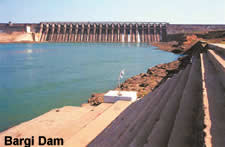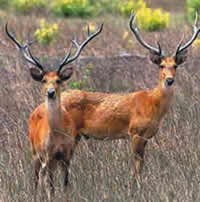
Dimdima
Online Children's Magazine from India

Dimdima
Online Children's Magazine from India

Around 8 km from the source, at the end of the Malwa plateau, the river takes a plunge down a 24-m-high black basalt cliff, to form the twin Kapildhara falls. In earlier times, people would plunge off the cliff in an act of ritual religious suicide. They were trying to appease the river goddess, known in her fearsome bloodthirsty form as Manasavardhani. Today, railings protect the unwary from plunging down into the torrent. The falls are named after the sage Kapila who is believed to have meditated here for a thousand years. One can climb down to the bottom of the falls and then walk behind the curtain of water.
The Padmapurana states that there are 60 crores and 60,000 holy ghats on the banks of the Narmada at Amarkantak. It is believed that anyone who dies by fire, drowning or by fasting on this mountain will never be reborn. The merit gained by a visit here is said to be equivalent to ten times that acquired by doing an aswamedha yagna! During the great churning of the ocean, when Shiva swallowed the deadly haalahala poison, he came to Amarkantak to cool his burning throat with the soothing waters of the Narmada. Amarkantak literally means ‘immortal throat’ (of Shiva).
From here, the Narmada descends to the plains towards Mandla, forming rocky basins en route, including a series of foaming waterfalls known as Doodhdhara.
The Narmada, fed by innumerable small streams along the way, increases in size as it reaches Dindori, 88 km from Amarkantak. Dindori is known for fossils – rocks with ferns and fossilized molluscs embedded in them. Near Mandla, the river is broken up by basalt rocks into swiftly-flowing streams, so numerous that the place is known as Sahastradhara or ‘a thousand cascades’. The huge flat rocks are believed to be remnants of an ancient dam. Fishermen with conical nets sit patiently under each cascade, waiting to catch fish that struggle up the slippery sides of the rocks only to fall back. Below Sahastradhara, the swift Narmada becomes a sheet of sluggish water backed up from the Bargi dam further downstream.Putrefying tree stumps at the edges of the river are all that remain of miles of prime teak forest that has been submerged. The Bargi dam was the first of the 30 major dams to be constructed on the Narmada. It was completed in 1990.
The world-famous Kanha National Park and tiger reserve is located in Mandla district, a five-hour drive from Jabalpur. The 1945-sq-km reserve is home to more than a 100 tigers. Kanha was actually set up in 1933 when a 250 sq km area was reserved for a sanctuary which survived well beyond India’s independence. Then in the early 1950’s, a privileged hunter was allowed to shoot 30 tigers in and around the sanctuary. The uproar that followed this incident led to Kanha being declared a national park in 1955. Since then, the park has slowly expanded to its present size.  The reserve succeeded in bringing back the ‘jewel of Kanha’ — the unique swamp deer called the barasingha — from the brink of extinction. These 1.27-m-tall deer have impressive antlers. ‘Barasingha’ literally means ‘twelve horns’. The barasingha population at Kanha has grown from 66 in 1968, to over 500 individuals at present. The reserve succeeded in bringing back the ‘jewel of Kanha’ — the unique swamp deer called the barasingha — from the brink of extinction. These 1.27-m-tall deer have impressive antlers. ‘Barasingha’ literally means ‘twelve horns’. The barasingha population at Kanha has grown from 66 in 1968, to over 500 individuals at present. Two important tributaries of the Narmada, the Banjar and the Halon flow through the sanctuary, providing a perennial source of water to the wildlife. |
Last updated on :12/5/2005
Dimdima is the Sanskrit word for ‘drumbeat’. In olden days, victory in battle was heralded by the beat of drums or any important news to be conveyed to the people used to be accompanied with drumbeats.
Bharatiya Vidya Bhavan
K. M Munshi Marg,
Chowpatty, Mumbai - 400 007
email : editor@dimdima.com
Bharatiya Vidya Bhavan
505, Sane Guruji Marg,
Tardeo, Mumbai - 400 034
email : promo@dimdima.com
Dimdima.com, the Children's Website of Bharatiya Vidya Bhavan launched in 2000 and came out with a Printed version of Dimdima Magazine in 2004. At present the Printed Version have more than 35,000 subscribers from India and Abroad.